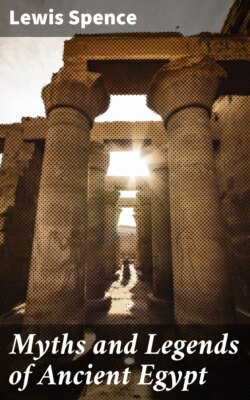Читать книгу Myths and Legends of Ancient Egypt - Lewis Spence - Страница 40
На сайте Литреса книга снята с продажи.
Mysteries
ОглавлениеThere is a popular fallacy to the effect that 'volumes' have been written concerning the Egyptian 'mysteries,' those picturesque and unearthly ceremonies of initiation which are supposed to have taken place in subterranean dusk, surrounded by all the circumstances of occult rite and custom. The truth is that works which deal with the subject are exceedingly rare, and are certainly not of the kind from which we can hope to glean anything concerning the mysteries of Egyptian priestcraft. We shall do better to turn to the analogous instances of Grecian practice or even to those of savage and semi-civilized peoples concerning whose mysteries a good deal has been unearthed of recent years.
Regarding the Egyptian mysteries but little is known. We have it on the authority of Herodotus that mysteries existed, possibly those in the case cited being the annual commemoration of the sufferings and death of Osiris. Says Herodotus:
"At Saïs in the Temple of Minerva, beneath the Churche and neere unto the walle of Minerva, in a base Chappell, are standinge certayne greate brooches of stone, whereto is adioyninge a lowe place in manner of a Dungeon, couered over wyth a stone curiously wroughte, the vaute it selfe being on euery side carued with most exquisite arte, in biggnesse matching with that in Delos, which is called Trochoïdes. Herein euery one counterfayteth the shadowes of his owne affections and phantasies in the nyghte season, which the Aegyptians call Mysteryes; touchinge whiche, God forbid, I should aduenture to discouer so much as they vouchsafed to tell mee."
In chapter i of the Book of the Dead, too, we encounter the phrase, "I look upon the hidden things in Re-stau"—an allusion to the ceremonies which were performed in the sanctuary of Seker, the god of death at Saqqara. These typified the birth and death of the sun-god, and were celebrated betwixt midnight and dawn. Again, in chapter cxxv of the Book of the Dead (Papyrus of Ani) we read, "I have entered into Re-stau [the other world of Seker, near Memphis] and I have seen the Hidden One [or mystery] who is therein."
Chapter cxlviii (Saïte Recension) is to be recited "on the day of the new moon, on the sixth-day festival, on the fifteenth-day festival, on the festival of Uag, on the festival of Thoth, on the birthday of Osiris, on the festival of Menu, on the night of Heker, during the mysteries of Maāt, during the celebration of the mysteries of Akertet," and so forth. Herodotus, who was supposed to have been initiated into these mysteries, is righteously cryptic concerning them, and just as he has aroused our interest to fever heat he invariably sees fit to remark that his lips are sealed on the subject.
But is there anything so very extraordinary in these terrible doings? Theosophists and others would lead us to suppose that in the gloomy crypts of Egypt weird spiritistic rites of evocation and magical ceremonies of dark import were gone through. What are the probabilities?
